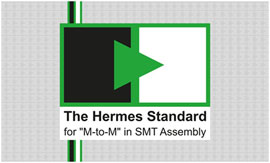 New “The Hermes Standard” communication protocol to advance Industry 4.0 in electronics manufacturing
New “The Hermes Standard” communication protocol to advance Industry 4.0 in electronics manufacturing
At a meeting in Munich, 16 leading equipment suppliers to the electronics manufacturing industry have agreed on the non-proprietary “The Hermes Standard for vendor-independent machine-to-machine communication in SMT assembly”. The TCP/IP- and XML-based protocol makes it possible for the first time to transport circuit boards with full traceability (i.e., no loss of data) through all stations of an SMT line. For electronics manufacturers, the new open standard promises to deliver more transparency while saving time and money when building and integrating SMT lines. As a result, the Hermes Standard may become a major building block of the smart SMT factory.
The initiative proposed by ASM Assembly Systems and ASYS to develop a new communication interface aimed to replace the obsolete SMEMA standard was overwhelmingly welcomed by most leading international SMT equipment manufacturers last year. 16 leading vendors of SMT equipment came together in Munich on March 22 to approve the first version of the open protocol. The specification will be published by the end of June so that third-party vendors can commence development activities as well. The goal is to introduce some first products that communicate with other line components via the Hermes Standard already at this year’s Productronica trade show (November 14 to 17 in Munich).

“The Hermes standard for vendor-independent machine-to-machine communication in SMT assembly” uses TCP/IP to allow all stations on an SMT line (printers, conveyors, placement machines, AOI systems, reflow ovens, etc.) to talk to each other. It also employs expandable XML data structures to transmit information like board IDs, conveyor speeds and circuit carrier dimensions. A major benefit: each board must be identified only once by a Hermes Standard-compatible machine at the start of the line. With its publication as an open standard, the Hermes standard will be available to all SMT equipment vendors at no cost. And since the protocol was designed to be expandable, users will over the medium term be able to pass additional information down the line.
The participants came from these 16 leading equipment vendors: ASM, ASYS, CYBEROPTICS, ERSA, KIC, KOH YOUNG, MIRTEC, MYCRONIC, NUTEK, OMRON, PARMI, REHM, SAKI, SMT, VISCOM and YJ LINK.
“Smart Factory calls for integration across the entire production floor. Different equipment vendors from the industry have to come together in order to provide the customer with intelligent, yet simple solutions. Exactly this is what the Hermes Standard aims to do: we want to establish an effective, simple standard for M2M communication – across the entire SMT line. This meeting with 16 leading equipment providers for the SMT production showed how great the need for such a standard truly is. As ASYS, we are proud to be directly involved already during the development phase. We are excited about this idea and will continue to actively drive it. Thanks to the Hermes Standard, we are getting closer to our idea of the Smart Factory, all the while focusing on customer-oriented solutions,”says Florian Ritter, Manager Business &Product Portfolio Development of the ASYS Group.
“We are overwhelmed by the positive response to the Hermes initiative. The fact that major SMT equipment vendors cooperated in creating a modern, future-oriented and open standard for communication and data exchange between all components of an SMT line demonstrates that we have accepted the challenges of Industry 4.0 and are doing our part to develop integrated and smart SMT factories. And we are doing it quickly – the Hermes Standard is expected to be finalized by the end of this year. This is excellent news for electronics manufacturers all over the world,” said Thomas Bliem, Director Product Management Placement Systems at ASM.







